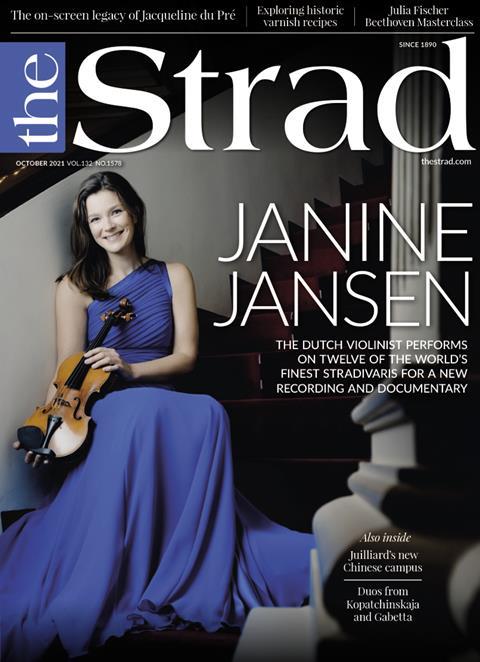Janine Jansen discovered different characteristics and quirks among the twelve Stradivari violins used in her recent recording and documentary, in this extract from the October 2021 issue

Photo: Justine Waddell
Jansen swaps instruments, sometimes phrase by phrase, as she tries to match them with repertoire
The following extract is from The Strad’s October 2021 issue feature ‘Janine Jansen: A Spiritual Connection’. To read it in full, click here to subscribe and login. The October 2021 digital magazine and print edition are on sale now
These twelve Stardivaris were not easy to come by. Ordinarily they are kept in private collections, locked away in vaults or loaned out to players worldwide, so it was a challenge to bring them together, especially during a pandemic. In the short two- to three-week window that this was possible, Jansen was to try each instrument and choose repertoire to suit it, then rehearse and record with her pianist, soon-to-be chief conductor of the LSO Antonio Pappano. New issues, however, followed. ‘After five days I tested positive for Covid, so that made it even more complicated,’ says Jansen, who was forced to take three weeks off to recover. ‘It was not easy for me to get back in shape so that I could practise and get to know the instruments. With some of them it was tricky: I was limited to a few days or even hours, so it was a big challenge to find the characters and voices.’
Even if Jansen had been able to spend the intended time with the instruments, she admits that to find each violin’s voice during recording would have been just as difficult, because there was so little time to adjust between pieces. ‘With some, you play just a few notes and it’s almost like you’re meeting an old friend,’ she says. ‘My “Shumsky” was an old friend from the first notes I played on it. Others may be more shy, so you need to find your way in, to make them blossom – it can take time to find where the instrument starts to react, and where you actually kill the sound.’ On occasion, she had to replan her fingerings to adapt, or to take a different approach to articulation and vibrato than she would on her own violin.
With the instruments that had been left unplayed in vaults in recent years, those voices themselves changed as Jansen got to know them. The 1715 ‘Alard, Baron Knoop’, which counts Joseph Joachim among its former players, had not been used for ten years and it had never, before Jansen, been recorded; the ‘Tyrrell’, too, is rarely played. ‘When you hear that piece of information before you have the instrument in your hands, you think, “That’s going to be difficult; it might be a bit closed,”’ says Jansen. ‘It wasn’t that way at all. The thing I noticed after playing the “Alard” for a few days was that the sound became even better. During the recording at Cadogan Hall, suddenly the sound became strong and heavy, and it started to buzz with this amazing sizzle.’ As its power grew, she had to find a way to control it, and it is fascinating to watch her react to that sound, and also to the brightness of the ‘Haendel’ E string, the ease of the ‘Vieuxtemps’, and the qualities of each other instrument, as the documentary progresses. She assures me that there were no disappointments – only some instruments that inspired her more than the others. ‘If I had to pick a few, I think that the “Shumsky”, the “Alard” and the “Tyrrell” were the ones that really stood out,’ she says. ‘But I feel guilty even for saying this, because they are all really very special.’
Of course, the way a violin responds has to do with more than just the instrument itself, and so Jansen experimented with strings and bows to find out how best to bring each violin alive. As a result, the recording features an assortment of Thomastik Rondos, Dominants and Peter Infelds, and Pirastro Evah Pirazzis – string brands that she is used to, and that she felt matched each instrument. ‘It makes such a difference,’ she says. ‘Of course, I’m used to playing a certain type of string, with a particular speaking quality, but it also depends on the character of the violin. Sometimes an instrument doesn’t need an extra-beautiful, warm string, because it is already warm and it just needs more clarity.’ Her two bows also had a dramatic effect. ‘It was interesting how everything changed,’ she says. ‘The “Alard” is quite extraordinary: it has an amazing richness and warmth, but it also has this extra gear. Even when you think it cannot give any more, it’s just like’ – she makes a sound like a revving sports car – ‘it goes! And my Dominique Peccatte bow, which is quite strong and heavy, worked very well with that instrument. My Persoit is lighter and brings out more overtones, but actually with the “Alard” it didn’t give enough. It didn’t help to lift the violin – it made it a little bit closed.’ With the ‘Captain Savile’ she found the opposite. ‘That violin is much more vulnerable, more intimate,’ she says. ‘It has a beautiful sound, but that strong bow crushes it. The Persoit lifts the sound and really makes the instrument breathe.’
Read: Janine Jansen: Twelve chosen Stradivaris
Read: Janine Jansen: A spiritual connection
-
This article was published in the October 2021 Janine Jansen issue
The Dutch violinist performs on twelve of the world’s finest Stradivaris for a new recording and documentary. Explore all the articles in this issue . Explore all the articles in this issue
More from this issue…
- Janine Jansen’s Stradivari recording project
- The on-screen legacy of Jacqueline du Pré
- Exploring historic varnish recipes
- Juilliard’s new Chinese campus
- Duos from Kopatchinskaja and Gabetta
- The Strad Calendar 2022
Read more playing content here
-



































No comments yet